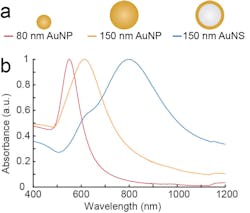Nanoparticles, NIR laser light combine to destroy cancer cells
Cancer treatments based on laser irradiation of tiny nanoparticles that are injected directly into the tumor are working and can destroy the cancer from within. Knowing this, researchers from the Niels Bohr Institute and the Faculty of Health Sciences at the University of Copenhagen (Denmark) have developed a method that kills cancer cells using nanoparticles and lasers. The combination treatment has been tested on mice, demonstrating that the cancer tumors were considerably damaged.
Related: NIR light-activated nanoparticles can precisely target and treat tumors
Traditional cancer treatments like radiation and chemotherapy have major side effects because they not only affect the tumors, but also the healthy parts of the body. A large interdisciplinary research project between physicists at the Niels Bohr Institute and doctors and human biologists at the Panum Institute and Rigshospitalet has developed a new treatment that only affects cancer tumors locally and therefore is much more gentle on the body. The project, called Laser Activated Nanoparticles for Tumor Elimination (LANTERN), is being led by Prof. Lene Oddershede, a biophysicist and head of the research group Optical Tweezers at the Niels Bohr Institute at the University of Copenhagen, in collaboration with Professor Andreas Kjær, head of the Cluster for Molecular Imaging at the Panum Institute.
After experimenting with biological membranes, the researchers have now tested the method on living mice. In the experiments, the mice are given cancer tumors of laboratory-cultured human cancer cells.
The treatment involves injecting tiny nanoparticles directly into the cancer, followed by heating up the nanoparticles from the outside using lasers. There is a strong interaction between the nanoparticles and the laser light, which causes the particles to heat up. What then happens is that the heated particles damage or kill the cancer cells, Oddershede explains.
The nanoparticles, which measure between 80 and 150 nm in diameter, consist of either solid gold or a shell structure consisting of a glass core with a thin shell of gold around it. Some of the experiments aimed to find out which particles are most effective in reducing tumors.Oddershede says that the research team would like the method to work by injecting the nanoparticles into the bloodstream, where they end up in the tumors that may have metastasized. "With the PET scans, we can see where the tumors are and irradiate them with lasers, while also effectively assessing how well the treatment has worked shortly after the irradiation. In addition, we will coat the particles with chemotherapy, which is released by the heat and will also help kill the cancer cells," she says.
Full details of the work appear in the journal Scientific Reports; for more information, please visit http://dx.doi.org/10.1038/srep30076.


